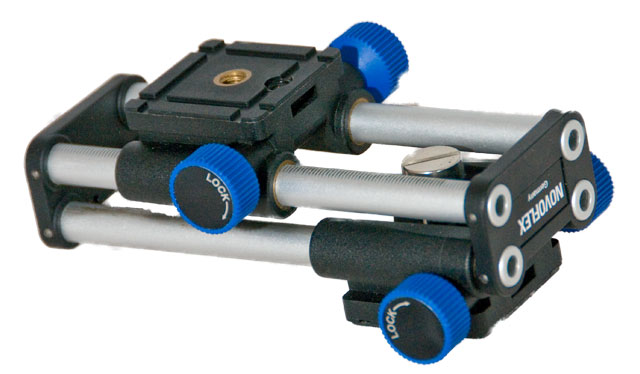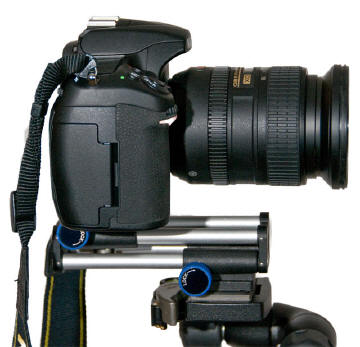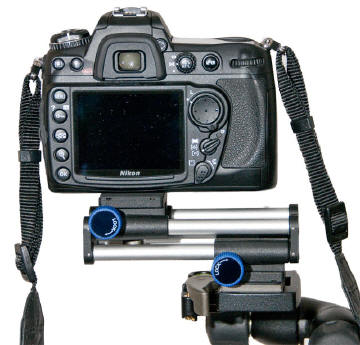Article
Novoflex Castel-Mini
The primary function of this device is as a
focusing rack. A focusing rack is used to allow the camera to be positioned
to the correct position for focusing and getting the correct depth of field,
by moving it at micro-millimetres. It's primary function is for use in Macro
photography allowing you to get closer to the subject and is recommended for
use with macro lenses. It is small and lightweight enough that it can travel
with the photographer out in the field.
This device is fitted to the tripod and the
camera is fitted to the rack. Its dual locking geared system is
controlled by two sets of knobs controlling the two focus drives, working on
a double rack system that allows it to achieve a movement of 135mm (5.3")
when the device is only 133mm long. The control knobs can be locked into
position, so once set up will not move by the impact of pressing the shutter
release on the camera or any other minor movement until you unlock it to
move the camera to a new position.
 
There are other uses for this small amount
of movement, as well as macro and that is in taking panoramas and for use in
3D photography. Let's take these in turn.
| Panoramas
Panoramas, unless you have a specialist camera
for panoramas, are achieved by taking a series of overlapping photos and
then within either specific software or editing packages like Photoshop, the
images are 'stitched' together to create a final image. To take good
panoramas the camera needs to be mounted on a tripod and the 'nodel' point
of the lens needs to stay in the same position throughout the series of
images taken. This not only gets the perspective of the final image right,
it also cuts down the amount of work required in the editing stage. You can
use the Novoflex focusing rack to help with this. By mounting the Novaflex
on your tripod, straight on, and then the camera on to this you can use the
rack and pinion to position the 'nodel' point (usually the aperture ring) at
the correct position on the tripod for the image you are taking. |

  |
|
3D Photography
3D Photography requires a minimum of two
photos, for those that can be viewed with the colour glasses, where they are
overlapped slightly to crate the image. For this reason the two images need
to be exactly parallel and the camera should be on a tripod. The effect of
what you are doing with the camera is mimicking your eyes and particularly
if you have only one camera this can be a difficult thing to achieve. The
positioning of the camera to achieve this is also dependent on what image
you are trying to make 3D, and therefore how far way you are from the
subject and the focal length of the lens has an impact. For example if
trying to do 3D of a macro image they amount of camera movement between the
two images is only about .25inch, whereas typically the distance is 4-5
inches. However using the Castel-Mini placed in a horizontal position on the
tripod and it's ability to move at very small increments it is possible to
take two images at the correct distances apart. To do live action 3D you
need to use two cameras and to do this you need to use a
Multi camera bracket  and a
Cable to parallel 2 cameras
and a
Cable to parallel 2 cameras  together to be able to take the picture at the same time.
together to be able to take the picture at the same time. |

 Click on smaller images for
larger versions
Click on smaller images for
larger versions

|
Features
Movement of 5.3" despite overall length of
5.1".
Both 3/8"x16 & 1/4"x20 threaded tripod
mounts.
5.1"L x 3.2"W x 2.2"H, 0.63 pounds.
Costs £115 from Speedgraphic in 2009.
A very useful and versatile accessory for
the photographers bag. When looking for this item in catalogues or on the
internet it will usually be under the close-up and Macro items and may be
with bellows and tubes systems.
See Also:
Fotomate
Sliding Plate 
Multi camera bracket 
Cable to parallel 2 cameras 
|